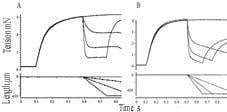In our previous studies, we used after-loaded and isotonic release techniques to determine the force-shortening velocity relation in rat muscle fibres at different temperatures (Ranatunga, 1984). However, the shortening velocities were determined only for loads of up to 50-60% of the isometric force. In order to determine a fuller force-shortening velocity relation in rat muscle, as has been done in frog and fish fibres (Lannergren, 1978; Altringham & Johnston, 1982; see refs in Julian et al. 1986), we have now begun a study using ramp shortening. Adult male rats (~250 g) were humanely killed. Small bundles (~5 fibres) were isolated from the flexor hallucis brevis (a fast muscle) of the foot and mounted horizontally in Ringer solution between a force transducer and servo-motor at 20°C. Initial fibre length (Lo) was ~2 mm and sarcomere length was ~2.5 μm. A fibre bundle was tetanized and on the tension plateau a ramp shortening up to 20% Lo in amplitude was applied at different velocities (0.01 to ~5 Lo per second), and the tension changes monitored. Figure 1A and 1B show some experimental records from two separate preparations, in each of which the tension responses to three shortening velocities are shown. A ramp shortening caused a rapid initial decrease in tension followed by a steady level in A, as expected. Whereas in B the initial decrease was followed by a slow decrease that continued till the end of the ramp shortening and did not reach a steady level of shortening velocity. Preliminary analyses have shown that the tension level at the end of the initial rapid tension decline could be used to obtain the force-shortening velocity curve; the maximal shortening velocity was 3.87 ± 0.45 (mean ± s.e.m., n=6), comparable to previous estimates for rat fast muscle (see Ranatunga, 1984). The reason for the two types of behaviour, A (n = 2) and B (n = 7), remains unclear. The cause of the continued slow tension decrease during ramp shortening (as seen in B) seems to suggest the occurrence of shortening-deactivation in some tetanized rat muscle fibres; indeed, shortening deactivation has been shown to occur in other preparations but typically with submaximal activation (Edman, 1975; Julian et al. 1986).
University of Bristol (2005) J Physiol 567P, PC80
Poster Communications: Tension responses to ramp shortening in tetanised intact muscle fibres of the rat
Roots, HR; Ranatunga, KW;
1. Physiology, University of Bristol, Bristol, United Kingdom.
View other abstracts by:
Figure 1. Tension responses (upper traces) to three ramp shortening velocities (lower traces) from two experiments (A and B) at 20°C; a bundle was held isometric for ~0.3 to 0.4 s before a ramp shortening was applied. An isometric tetanus is also superimposed in each case. Note that in A there is a rapid decrease in tension to a steady level as expected whereas in B the initial rapid decrease is followed by a slow tension decline that continues until the end of the ramp.
Where applicable, experiments conform with Society ethical requirements.

